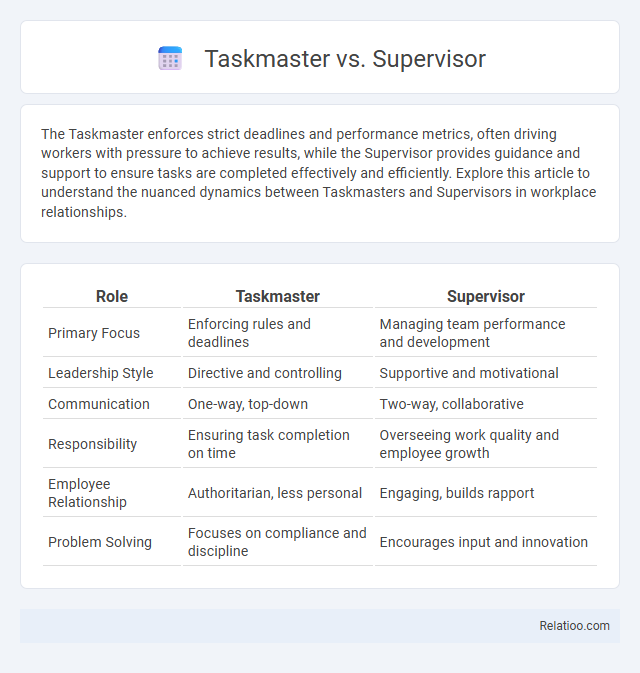The Taskmaster enforces strict deadlines and performance metrics, often driving workers with pressure to achieve results, while the Supervisor provides guidance and support to ensure tasks are completed effectively and efficiently. Explore this article to understand the nuanced dynamics between Taskmasters and Supervisors in workplace relationships.
Table of Comparison
| Role | Taskmaster | Supervisor |
|---|---|---|
| Primary Focus | Enforcing rules and deadlines | Managing team performance and development |
| Leadership Style | Directive and controlling | Supportive and motivational |
| Communication | One-way, top-down | Two-way, collaborative |
| Responsibility | Ensuring task completion on time | Overseeing work quality and employee growth |
| Employee Relationship | Authoritarian, less personal | Engaging, builds rapport |
| Problem Solving | Focuses on compliance and discipline | Encourages input and innovation |
Understanding the Roles: Taskmaster and Supervisor
Taskmaster and Supervisor hold distinct roles in managing tasks and teams, with the Taskmaster primarily focused on ensuring tasks are completed promptly and efficiently, often emphasizing results over processes. Supervisors, however, balance task oversight with employee development, providing guidance, support, and performance feedback to maintain productivity and morale. Understanding your role clearly helps optimize team dynamics and achieve project goals effectively.
Key Responsibilities of a Taskmaster
The Taskmaster is primarily responsible for assigning workload, monitoring progress, and ensuring deadlines are met efficiently within the team. Unlike supervisors who oversee overall operations and manage employee relations, the Taskmaster focuses on task execution, quality control, and meeting project milestones. Your role as a Taskmaster involves coordinating team efforts to optimize productivity and maintain high standards in task completion.
Core Duties of a Supervisor
A Supervisor primarily oversees team performance, ensuring tasks are completed efficiently while maintaining quality standards. You coordinate resources, monitor progress, provide guidance, and resolve issues to meet organizational goals. Unlike a Taskmaster who strictly enforces deadlines or a micromanager imposing control, a Supervisor balances leadership and support to optimize workflow and employee productivity.
Leadership Styles Compared
Taskmaster leadership emphasizes strict control, clear rules, and high expectations to drive productivity, often focusing on task completion rather than employee morale. Supervisor leadership balances oversight with support, monitoring performance while providing guidance and feedback to foster team development. Compared to taskmasters, supervisors adopt a more interactive and communicative approach, while taskmasters prioritize efficiency and authority, highlighting distinct leadership styles in managing teams.
Approaches to Team Management
Taskmaster emphasizes strict control, clear deadlines, and close monitoring to drive team performance, often prioritizing efficiency over flexibility. Supervisor adopts a more balanced approach, fostering communication and support while ensuring tasks are completed, blending oversight with motivational techniques. Taskmaster's approach can lead to high productivity in structured environments, but Supervisor may better manage dynamic teams by encouraging collaboration and adaptability.
Communication Differences
Taskmaster communication emphasizes directive clarity and task-oriented instructions to ensure efficient execution of specific duties. Supervisors prioritize interactive communication, balancing delegation with feedback and support to foster team collaboration and development. Taskmasters tend to rely on top-down communication with limited dialogue, while supervisors engage in two-way communication that encourages questions and input from team members.
Impact on Workplace Productivity
Taskmaster and Supervisor roles influence workplace productivity through distinct approaches to task management and employee motivation. You will find that Taskmasters emphasize strict deadlines and high-pressure tactics, often resulting in short-term productivity boosts but potential employee burnout. Supervisors, conversely, balance performance expectations with support and guidance, fostering sustainable productivity and higher employee engagement.
Skills and Qualities Required
Taskmaster roles demand strong leadership skills, including authoritative decision-making, effective delegation, and a firm approach to enforcing deadlines and quality standards. Supervisors require excellent communication, conflict resolution, and team motivation abilities to foster collaboration and ensure productivity while managing workflow. Your success in either position hinges on balancing these skills with qualities like empathy, organization, and adaptability to meet operational goals efficiently.
Pros and Cons of Each Role
Taskmasters enforce strict deadlines and ensure task completion with high efficiency, but their rigid approach can lead to low employee morale and creativity suppression. Supervisors balance task management with team support, fostering collaboration and motivation, though they may face challenges in maintaining strict productivity standards. Taskmasters excel in driving results under pressure, supervisors excel in enhancing team dynamics, and the best choice depends on the organizational goals of efficiency versus employee development.
Choosing the Right Leadership Style
Choosing the right leadership style between Taskmaster, Supervisor, and Taskmaster approaches depends on your team's needs and project goals. A Taskmaster enforces strict deadlines and high standards, ensuring maximum productivity, while a Supervisor balances oversight with support, promoting team development and accountability. Assess your team's dynamics and project complexity to tailor your leadership style, maximizing efficiency and employee satisfaction.

Infographic: Taskmaster vs Supervisor
 relatioo.com
relatioo.com